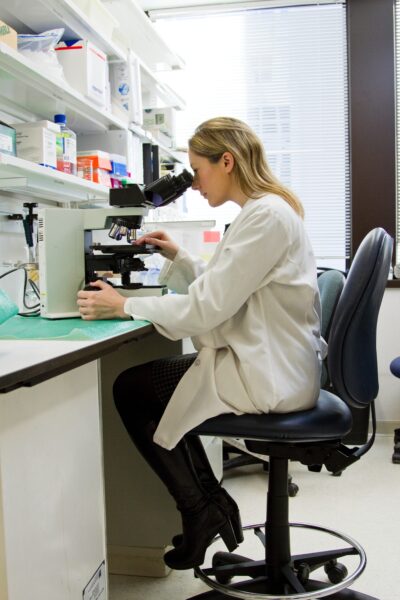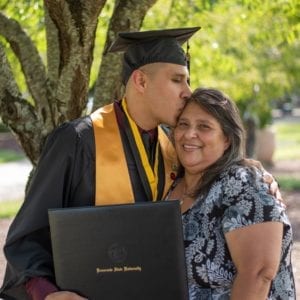Sanctioned by the Ministry of Education of China, Shenzhen University was founded in 1983. The Central Government, the Ministry of Education, and the local government attached great importance to higher education in Shenzhen Special Economic Zone. The University has received support from Peking University for establishing the School of Chinese Language and the School of Foreign Languages, from Tsinghua University for establishing the College of Electronic Science and the College of Architecture, and from the Renmin University of China for establishing the College of Economics and the Law School. Since its inception, the University has been committed to education reforms with regards to developing scholarship programs and work-study programs, adopting a modern academic credit system, providing students with a wider range of job opportunities, improving the quality of student services, and introducing a modern tenure-track system. Many reform policies have been recognized as breaking new ground on the scene of Chinese higher education.
Since its foundation 36 years ago, Shenzhen University has closely followed the pace of Shenzhen Special Economic Zone and has been committed to reform and rapid development. The Universityadheres to the motto of "self-reliance, self-discipline, self-improvement" and strives to become "the Special Economic Zone University, the Window University, and the Experimental University." The University is committed to high-quality social service in the pursuit of excellence in teaching, learning, and research. It is a comprehensive university which offers a wide range of undergraduate and postgraduate programs and provides leading-edge facilities and excellent services to students, faculty and staff. As a unique institution of higher learning in the Shenzhen Special Economic Zone, the University promotes a distinctive and innovative campus culture. With the establishment of Chinese cultural and arts research centers such as the JaoTsung-I Institute of Culture Studies and the Liu Yuyi Institute of Fine Arts, the University seeks acute cultural self-awareness and cultural self-confidence, in the context of building a world-class university with Chinese characteristics that matches the international stature of Shenzhen Special Economic Zone.
With four campuses in Yuehai, Canghai, Lihua and Luohu, Shenzhen University covers a total area of 2.72 square kilometres. The University provides students, faculty, and staff with rich teaching resources and scientific research facilities. The SZU Library has more than 4,120,000 books and 377 databases, which contain 2,580,000 full-text e-books and 119,000 full-text electronic journals. The University has a National Undergraduate Education Reform Center, a National Education Innovation Center, a National Teaching Practice Center, two National Teaching Demonstration Centers, a National Virtual Teaching Center, sixteen Provincial Teaching Demonstration Centers, and three Provincial Virtual Teaching Center. Additionally, there are three national engineering laboratories, one national engineering center, two key laboratories of the Ministry of Education, and 10 provincial key laboratories.
The University has been fully committed to supporting research excellence. In 2018, the University budgeted more than 1.1 billion yuan in research. There were 302 new projects supported by the National Natural Science Foundation of China, ranking 23rd in China and 2nd in Guangdong Province, and 33 new projects supported by the National Social Science Foundation of China, ranking 36th in the country and 4th in Guangdong Province. Our faculty published a total of 3,293 papers in SCI indexed journals and 238 papers in SSCI indexed journals, received 2,846 scientific research awards, and were granted 425 patents (including 229 invention patents). The Journal of Shenzhen University, Science and Engineering Edition has won the 2018 China University Science and Technology Periodical Excellence Award, and the Journal of Shenzhen University, Social Sciences Edition is ranked 13th in university journals in China with regards to the number of citations received.
The University proactively promotes "internationalization in talents training, research cooperation, faculty development, and cultural exchanges." It has worked with 256 overseas universities to provide high-quality student exchange programs, joint degree programs, research collaborations, and a variety of other forms of international collaboration and partnerships.
With the strong backing of Shenzhen municipality, SZU has evolved alongside socioeconomic development of the Guangdong-Hong Kong-Macau Greater Bay Area. Facing the world, the University will foster high-quality innovative and entrepreneurial talents in the spirit of reform and innovation, strive for cultural leadership to realize innovative and qualitative development, and build the high-level Special Economic Zone University for the people.
Shenzhen University was established in 1983 with the approval of the Ministry of Education. The central government, the Ministry of Education, and local governments attach great importance to the construction of universities in the Special Economic Zone. Peking University helped build Chinese and foreign language disciplines, Tsinghua helped build electronics and architecture disciplines, and the People's Congress helped build economics and law disciplines. A large number of well-known scholars gathered in Shenzhen University. At the beginning of the establishment of the school, the school was determined to reform the management system of the university, and actively explored scholarships, credit systems, and work-study programs. It took the lead in implementing a system of non-inclusive distribution of graduates and a two-way selection system in China, and a full-time employment system for staff and logistics. The reform of departmental socialization management has caused strong repercussions throughout the country.
After 36 years of establishment, Shenzhen University follows the Special Economic Zone and is committed to reform and rapid development. Adhering to the school motto of “self-reliance, self-discipline, and self-reliance”, the school has formed the school characteristics of “SAR universities, window universities, and experimental universities. The system has become a comprehensive university with complete disciplines, complete facilities, excellent teachers, and standardized management. Shenzhen University is a national cultural education base for college students and a national civilized campus. In order to achieve the connotative development of higher education, the school has formulated the "Outline of Cultural Innovation and Development of Shenzhen University", established the Rao Zongyi Cultural Research Institute and Liu Yuyi Art Academy to build a first-class socialist special zone with Chinese characteristics with a high degree of cultural awareness and confidence University culture.
Shenzhen University currently has four campuses in Guangdong, Canghai, Lihu, and Luohu, with a total campus area of 2.72 square kilometers. The school has abundant teaching resources and complete scientific research facilities. The total construction area of the campus is 1.469 million square meters, and the total value of teaching and scientific research equipment is 2.8 billion yuan. The library building is 53202㎡ (including the first phase of the Lihu Campus Library), with more than 4.18 million volumes of paper resources; 384 types of databases, including 2.64 million full-text electronic books and 128,000 full-text electronic periodicals. There are 1 national-level undergraduate comprehensive reform pilot, 1 national-level talent training model innovation experimental area, and 1 national-level practical teaching base. There are 2 national experimental teaching demonstration centers, 1 national virtual simulation experimental teaching center, 16 provincial experimental teaching demonstration centers, and 3 provincial virtual simulation experimental teaching centers. There are 3 national engineering laboratories, 1 national engineering technology research center, 2 key laboratories of the Ministry of Education, 1 international cooperation base of the Ministry of Science and Technology, and 11 provincial key laboratories.
Shenzhen University currently has 37,684 full-time students, including 28,632 full-time undergraduates, 8,337 postgraduates, 301 doctoral students, 414 international students, and 23,706 adult education students. The school's disciplines are complete and comprehensive, covering 11 disciplines such as philosophy, literature, economics, law, education, science, engineering, management, medicine, history, and art. The school has 24 teaching colleges, two directly affiliated hospitals, and 97 undergraduate majors. There are 5 national specialties, 14 provincial specialties, and 15 provincial key disciplines. There are 10 first-level disciplines authorized by doctorates; 9 post-doctoral research stations and 1 post-doctoral workstations. There are 38 first-level disciplines authorized by master's degree; 22 professional master's degree authorized categories. Engineering, clinical medicine, materials science, biology and biochemistry, computer science, chemistry, and physics entered the top 1% of ESI disciplines in the world, ranking 84th in the ESI highly cited papers list of Chinese universities. The school initiated the establishment of the "National UOOC Alliance of Local Universities", joining 131 universities, 413 courses, a total of 119 elective schools, a total of 61 accredited schools, and a total of 700,000 elective students. Undergraduates in the 2018-2019 school year have won 773 competition awards at various levels, including 87 at the international level, 337 at the national level, and 328 at the provincial and ministerial levels.
The structure of the school's teaching staff has been continuously optimized, and high-level talents have been introduced and trained with fruitful results. There are 3660 faculty members, including 2350 full-time teachers (543 professors, 667 associate professors), 544 technical staff, and 766 management staff. There are 1368 postdoctoral fellows, 559 full-time researchers, and 178 visiting professors. There are 18 members of the Chinese Academy of Sciences and the Chinese Academy of Engineering (including 6 short-term appointments), 2 members of the American Academy of Medical and Biological Engineering, 3 members of the American Academy of Sciences, Engineering, and Academy of Medical Sciences (short appointment), 1 member of the Royal Academy of Engineering, and member of the Canadian Academy of Engineering 2 persons, 2 members of the Japanese Academy of Engineering, 1 member of the Russian Academy of Engineering, 3 members of the European Academy of Sciences (short-term), 1 member of the Singapore Academy of Sciences (short-term), 1 member of the Royal Canadian Academy of Sciences (short-term), academician of the Royal Netherlands Academy of Sciences 1 person (short-term), 1 member of the Australian Academy of Sciences (short-term), 3 members of the Eurasian Academy of Sciences, and 1 Nobel Prize (physical and medical) winner (short-term). The full-time high-level talent team includes 5 chief scientists of the National "973 Program", 19 nationally-appointed experts (including foreign projects), 28 nationally-appointed experts (youth projects), 9 Yangtze River scholars, and winners of the National Outstanding Youth Science Fund 19 people, 15 winners of National Outstanding Youth Science Fund, 9 people from the Ministry of Education "Excellent Talents of the New Century", 3 people from the 10,000-person plan.
The school continued to deepen the reform of the scientific research system, with significant growth in scientific research projects and funding. In 2019, the total funding for scientific research exceeded 1.1 billion yuan; the National Natural Science Foundation of China won 365 projects, ranking 16th in the country and second in Guangdong universities; in 2018, it won 33 national social science fund projects, ranking 36th in the country. 4th in Guangdong universities. There are 3791 papers included in SCI and 381 papers included in SSCI. Received 2,846 scientific research awards. 425 patents were authorized, including 229 invention patents. The science and engineering edition of the journal has been awarded the "2018 Top 100 Scientific and Technological Journals of Chinese Universities"; the number of reprints of the humanities and social sciences of the journal ranks 13th in the national university journals.
The school actively promotes "international talent training, international scientific research cooperation, international teacher construction, and international cultural exchange." It has established links with 289 overseas universities and carried out various forms of international cooperation such as student exchange, teacher training, and cooperative education. Comprehensively improve the quality and level of international exchanges.
Shenzhen University will continue to be based in Shenzhen, relying on the economic and social development of the Guangdong-Hong Kong-Macao Greater Bay Area, facing the world, and cultivating high-quality innovative entrepreneurial talents in the spirit of reform and innovation, adhere to cultural leadership, strengthen innovation drive, realize connotative development, and build The people of the era are striving for high-level universities that are satisfied with the times.









